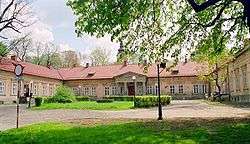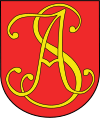Andrychów
Andrychów [anˈdrɨxuf] (![]()
Andrychów | |
|---|---|
 Manor in Andrychów | |
 Flag  Coat of arms | |
 Andrychów | |
| Coordinates: 49°52′N 19°20′E | |
| Country | |
| Voivodeship | Lesser Poland |
| County | Wadowice |
| Gmina | Andrychów |
| Established | 13th century |
| Town rights | 1767 |
| Government | |
| • Mayor | Tomasz Żak |
| Area | |
| • Total | 10.28 km2 (3.97 sq mi) |
| Elevation | 333 m (1,093 ft) |
| Population (2006) | |
| • Total | 21,691 |
| • Density | 2,100/km2 (5,500/sq mi) |
| Time zone | UTC+1 (CET) |
| • Summer (DST) | UTC+2 (CEST) |
| Postal code | 34-120 |
| Area code(s) | +48 33 |
| Car plates | KWA |
| Website | http://www.um.andrychow.pl |
Name and Location
Andrychów is a tourist centre in the Little Beskids. Tourist attractions include the old town with historic park, baroque church, an 18th-century manor and a Jewish cemetery. Andrychów has a well developed tourist infrastructure: accommodation, theme parks, active recreation infrastructure and local museums. The town lies at the intersection of National Road nr. 52 (Kraków - Bielsko-Biała), and local road nr. 781. Furthermore, Andrychów has a rail station along the line nr. 117 (Bielsko-Biała–Kalwaria Zebrzydowska Lanckorona). Mass transit is provided by buses of the Intercommune Transit Authority (Miadzygminny Zaklad Komunikacyjny) Andrychów–Kęty–Porabka, which has 18 lines, including 6 in Andrychów itself.
The settlement dates back to the late 13th century. First recorded mention of it comes from 1344's Peter's Pence, and it was called Henrychów (ecclesia de Henrichov). Other names used for Andrychow in the past are Indrzychow, and Gendrzychow. During the German occupation of Poland, it was renamed into Andrichau. Historians claim that the name of the town comes from a Polish given name Jedrzej (Andrzej).
History
Andrychów was first mentioned in the records of Peter's Pence in 1344 as a small village in the Duchy of Zator, however an existing church was already mentioned in 1325. In 1345 Andrychów is said to have population of 105 and to cover the area of 27 km2. Most likely, its first residents were settlers from Klatovy in southern Bohemia. Jan Długosz in his Liber beneficiorum calls it Gendrychow, writing that it was a small village in the Silesian Duchy of Zator. In ca. 1440 the Zator Castle was captured by Polish troops, and finally, the Duchy of Zator, together with Duchy of Oświęcim were incorporated into Kingdom of Poland on February 20, 1564, as Silesian County of Kraków Voivodeship, Lesser Poland.
During the reign of Zygmunt August, Andrychów emerged as an administrative center of the area. The village belonged to the family of Schilling, who supported Protestant Reformation. In 1655, during the Swedish invasion of Poland, Andrychów was burned by Swedish units heading for Żywiec. In 1704, first attempt to grant town charter to Andrychów took place, but it did not succeed. Three years later the village was once again burned to the ground by the Swedes, during the Great Northern War. After the destruction, Andrychów's owner invited weavers from Silesia, Belgium and Saxony, and as a result, Andrychów became an important center of weaving. Finally, in 1767 it received town charter from King Stanisław August Poniatowski.
In the summer 1772 (see Partitions of Poland), Andrychów was seized by the Austrian troops. New authorities changed its name into Andrichau, and until November 1918, it remained in Austrian province of Galicia. For some time, both the village of Andrychów and the town of Andrychow existed. In 1778 the village had the population of 598, and the town 2,475. In 1791, first school was opened in the town. in the mid-1800s, the Industrial Revolution reached Andrychów, together with an influx of Jewish settlers, for whom a synagogue was built in 1884. On June 27, 1868, the town and the village were merged, and two years later, Andrychów received its first rail connection. On June 20, 1893, large parts of the town burned in a fire.
In the Second Polish Republic Andrychów belonged to Kraków Voivodeship. In 1926 the town was electrified, and in 1934 - 1939, several public works projects were carried out, including a sewage system, improved road system, a swimming pool and a municipal stadium. First gas station was opened in 1929, and since 1926, the town had regular bus connections with Kraków and Bielsko-Biala.
On September 4, 1939, Andrychów was captured by the Wehrmacht. The town was incorporated directly into the Third Reich, and on November 24, 1939, the Germans burned the local synagogue. During The Holocaust, most local Jews perished in Auschwitz. Germans retreated westwards on January 26, 1945, and next day Andrychów was captured by the Red Army. In the Polish People's Republic, Andrychów was an important center of textile industry, with a large cotton plant (Zakłady Przemysłu Bawełnianego). Another important factory was Andrychów Machine Works (Andrychowska Fabryka Maszyn), which was based on the German World War II-era factory Areo-Stall Werke.
International relations
Twin towns — Sister cities
Andrychów is twinned with:
External links
- Andrychow.pl - local news portal
- Jewish Community in Andrychów on Virtual Shtetl
- Andrychów, Poland at JewishGen
| Wikimedia Commons has media related to Andrychów. |